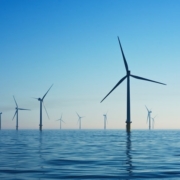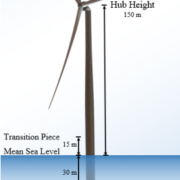Offshore Wind Industry
With increased use of offshore wind energy, a new industry sector with a broad spectrum of stakeholders from various industry and service sectors is developing. The value chain extends from turbine planning and financing to production of offshore wind turbines and large components; from transport and erection through to service and maintenance of wind farms. On account of the heavy demands associated with turbine transportation, construction and erection, the expansion of offshore wind energy presents additional challenges for participating companies from the wind industry, in comparison with onshore exploitation.
1. Industrial Production and Manufacturing
Wind turbine manufacturers
Internationally operational companies are involved in manufacturing of offshore turbines. Alongside companies that service both the onshore and offshore markets, offshore wind turbine manufacturers also include a small number of producers focussing solely on the offshore market. In addition, some turbine manufacturers are part of industrial groups offering conventional energy production plans as well as onshore and offshore wind energy turbines.
Suppliers and component manufacturers
The supplier industry is a central part of the offshore value chain. Suppliers include, in particular, companies from industry sectors such as steelwork and mechanical and electrical engineering. Important supplier companies within the offshore sector include manufacturers of large components such as transmission units, foundation structures and towers as well as parts and components for powertrains, rotor blades and cables.
2. Project planning and development
Project planning and development companies
Planning and implementation of offshore wind farms are often managed by specialised companies. The project developer’s tasks include selection of a location, land use planning and categorization, analysis of wind climatic conditions at the planned location, selection of plant configurations and implementation of approval procedures. Project developers are also responsible for wind farm construction and for handover to the operator/investor. Project developers often involve other specialised service providers in offshore projects who are responsible for the accompanying ecological investigations, for example.
3. Financing and Insurance
Banks and financial institutions
Due to the high investment costs associated with offshore wind farms, projects are generally implemented by project consortia and are credit-financed by private or public banks. Groups of investors include large corporations, banking partnerships and municipal utilities, amongst others. Smaller companies and private investors may also participate in offshore projects, by purchasing bonds for the purpose of capital generation, for example.
Insurance companies
Ambitious expansion targets for offshore wind energy in various countries are leading to increased numbers of offshore wind farms and to stronger demand for insurance services as a result. Risk management presents a major challenge on account of the large sums invested in offshore wind turbines. There are a range of risks associated with such projects, from ground investigation to offshore transport, to making an offshore wind farm operational.
4. Construction and maintenance
Transport and logistics companies
The transport and logistics sector has a central function in the construction of offshore wind farms because of the dimensions of wind turbines and large components, some of which are erected in coastal-remote areas and often in rough weather conditions. Special ships such as installation and transport vessels are required for the construction of offshore wind farms. Within the logistics sector, shipyards have an important role to play. Along with major international shipyards which benefit from contracts for special offshore installation vessels, for example, smaller shipyards are also involved in the construction of service and supply vessels in the offshore sector. Maritime ports are another stakeholder group in the logistics sector, involved in transshipment and transport of turbines and components.
Construction companies
Turbine erection, transformer platform construction and cable laying are managed by specialised construction companies. They use specialist machinery e.g. to erect the foundations or jack-up vessels with specialist cranes required for the installation of rotor blades, for example. Several companies are often involved in projects as consortia.
Grid operators
The transmission system operators (TSOs) are responsible for offshore wind farm grid connection. They are legally required to connect the offshore wind turbines to the electricity grid. The question of which TSO is responsible for connecting a particular wind farm depends on the control area in which the offshore wind turbine is to be connected to the grid. The TSO responsible is the one in whose control area the offshore farm has been erected. In addition to connecting to the grid, the grid operator is also responsible for ensuring stable grid operation.
Wind service and maintenance companies
Offshore wind farm operators expect undisturbed wind farm operation. In this respect, service and maintenance of turbines at sea plays an important role in operational management. Maintenance is managed by the turbine manufacturer or by external service providers. Foundation structures and rotor blades are relatively high-maintenance in offshore wind energy. Service and maintenance companies use diving robots to examine foundation structures, for example, or conduct measures to facilitate early recognition of damage to rotor blades.
5. Testing and certification
There are a range of international requirements to be observed when constructing offshore wind farms. Independent testing and certification bodies offer their services in order to ensure high quality in implementing an offshore wind farm project.
6. Operation of offshore wind farms
Offshore wind farm operators include large national and international electricity suppliers, municipal utility groups, individual municipal utilities, or project development companies.
Source: https://www.offshore-windindustry.com/economy/wind-industry




